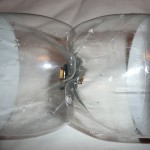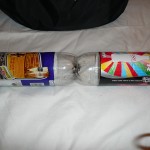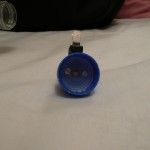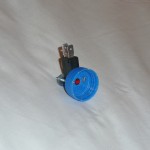Over the last few days I have been watching the videos from the competition over and over to try an get to the bottom of Louie veering off course at the start of the launch. I have also been discussing the problem at the Yahoo Water Rocket mailing list (see: http://groups.yahoo.com/group/water-rockets/message/8435)
One thing is for sure, that the rocket is stable in flight, its centre of gravity is well above its centre of pressure. Also the rocket only seems to be unstable at low velocity’s, this confirms that once sufficient velocity has been achieved and drag is being generated by the fins, the rocket is stable.
Various reasons have been suggested for why the rocket is unstable at low speeds, including cross winds, not enough pressure, a bent rocket or a off centred nozzle.
The low launch pressure means that the rocket will have low take off velocity so the fins won’t generate drag for the first several meters of flight, during this period the rocket will be very susceptible to external forces that may try to steer the rocket off course.
Of the remaining causes I suspect the most likely one might be the off centred nozzle. I can’t confirm since the nozzles have since been removed from the rockets and some unfortunately lost.
One very good suggestion was to angle the fins along the vertical plane by 5 degrees, this should put the rocket into a spin thus canceling out any off centred nozzle or bent rocket. The only thing that remains to be seen is if the rocket will be traveling fast enough for the fins to make the rocket spin. I intend to test this next week and report the results.















